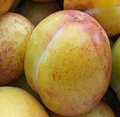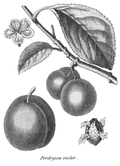This is a list of plum cultigens.
Table of plums
| Common name | Image | Color | Additional information | Refs |
|---|---|---|---|---|
| Alderman | Burgundy | Large yellow fleshed fruit. From Minnesota | ||
| Arandana | ||||
| Amber Jewel | Crimson Red | Skin with an orange or gold blush | ||
| Black Amber | 
|
Dark Crimson | ||
| Black Ice | Dark Blue | Red flesh and tough skin, vigorous and hardy | ||
| Bullace | 
|
Blue | ||
| Casselman | Red | Smooth-skinned and can be either fairly firm or slightly soft and are very sweet | ||
| Damson | 
|
Blue | ||
| El Dorado | Dark Purple | Has amber flesh and a sweet flavor even when firm | ||
| Greengage | 
|
Green | ||
| Laetitia plum | 
|
Red | ||
| LaCrescent | Yellow | Yellow flesh, freestone | ||
| Lemon plum | 
|
Yellow | ||
| Mirabelle | 
|
Yellow | ||
| Mount Royal | Deep blue | Yellow-green flesh, hardiest of the European plums | ||
| Opal | 
|
Light red | Bred in Sweden and released in 1925. A cross between a plum and a gage. | |
| Perdrigon | 
|
|||
| Pembina | Red (with blue bloom) | Yellow flesh. From South Dakota | ||
| Pipestone | Red | Very large fruit with yellow sweet juicy flesh, clingstone | ||
| Queen Garnet | Dark red | Red flesh. Rich in anthocyanins. Originated in Australia | ||
| Reine-Claude | 
|
Yellow | ||
| Santa Rosa | Red-violet | |||
| Superior | Red | Large fruit with yellow sweet juicy flesh, clingstone | ||
| Toka | Red | Yellow flesh, also known as the bubblegum plum. From South Dakota | ||
| Underwood | Red | From Minnesota, medium yellow fleshed fruit | ||
| Victoria | 
|
Red | ||
| Waneta | Red | Yellow flesh, prolific. From South Dakota |
References
- ^ "Fruit Variety" (PDF). sdstate.edu. South Dakota State University. Retrieved 7 June 2022.
- "Amber Jewel Plums Information and Facts". Specialty Produce.
- ^ "Fruit Variety". berkeleywellness.com.
- Plum Variety Descriptions, Michigan Plum Growers
- LAETITIA, stargrow.co.za
- Plum tree species - an overview, orangepippintrees.co.uk
- Fanning K; Edwards D; Netzel M; et al. (November 2013). "Increasing anthocyanin content in Queen Garnet plum and correlations with in-field measures". Acta Horticulturae. 985 (985): 97–104. doi:10.17660/ActaHortic.2013.985.12.